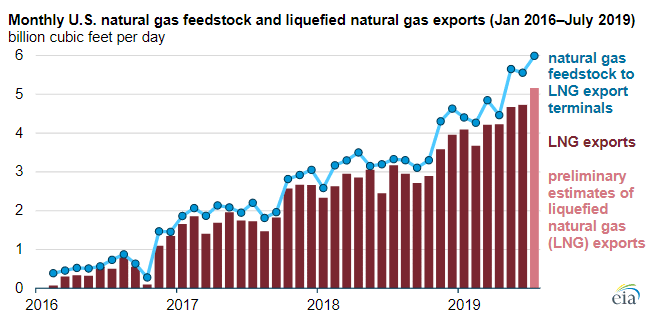Gas Deliveries to U.S. LNG Export Terminals Hit Record as New Facilities Come Online: EIA

Natural gas feedstock deliveries to LNG export facilities were the fastest growing among all U.S. natural gas consumption sectors in the first seven months of 2019, according to an Aug. 19 report from the U.S. Energy Information Administration. Deliveries to export terminals set a new monthly record in July, averaging 6.0 billion cubic feet per day.
- The 6.0 Bcf/d in feed gas deliveries in July accounted for 7 percent of total U.S. dry natural gas production, the agency said, citing data from OPIS PointLogic Energy.
- Based on the 6.0 Bcf/d of deliveries in July and 5.5 Bcf/d in June, the export figures suggest that about 15 percent of feed gas sent to LNG facilities were used for fueling the liquefaction process.
- Deliveries by pipelines to Mexico and U.S. LNG export facilities averaged 10.0 bcf/d in the first seven months of this year, 30 percent more than in the same period of 2018.
- U.S. LNG exports set new records in June and July 2019 at 4.8 Bcf/d and 5.2 Bcf/d, respectively, based on tanker loadings data from Bloomberg L.P.
- Currently, the U.S. has an export capacity of 5.4 bcf/d across four facilities and nine liquefaction trains.
- Two new liquefaction trains, the Cameron LNG Train 1 in Louisiana and Corpus Christi LNG Train 2 in Texas, began operations in the first half of 2019; two more export facilities – Elba Island in Georgia and Freeport in Texas – are expected to place their first trains in service in the next two months.
EnerKnol Pulses like this one are powered by the EnerKnol Platform—the first comprehensive database for real-time energy policy tracking. Sign up for a free trial below for access to key regulatory data and deep industry insights across the energy spectrum.
ACCESS FREE TRIAL